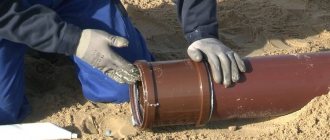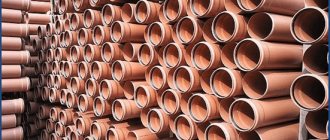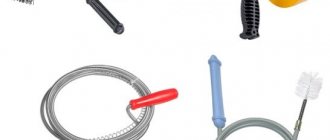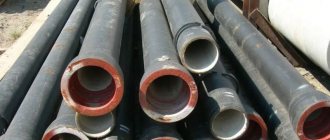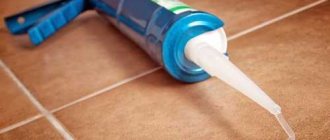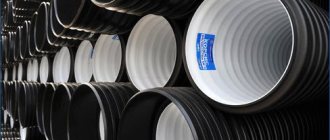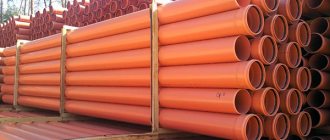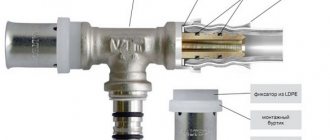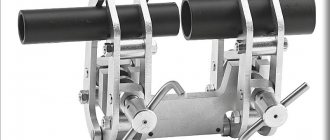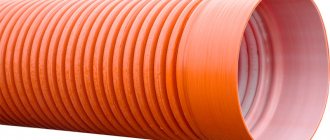Installation of a sewer pipe system involves the use of auxiliary components called fittings. Fittings for sewerage when assembling drainage systems are used as connectors for water supply pipes. With the help of these parts, outlets are created from the main sewage water pipelines.
Fittings for sewerage when assembling drainage systems are used as connectors for water supply pipes.
The use of these structural elements makes it possible to construct complex water pipelines designed to drain wastewater.
In the past, domestic wastewater systems were installed using structural parts made from cast iron. For such drainage systems, cast iron connecting parts were used. Today, cast iron water conduits for domestic wastewater are everywhere being replaced by systems made of PVC.
Sewage systems made of polyvinyl chloride
Relatively recently, cast iron products and metal fittings were used when installing sewer systems in private and multi-storey buildings.
To carry out installation work, it was necessary to use different welding methods, mainly electric welding. But today, when creating external and internal sewer networks, they use PVC pipes and fittings for sewerage (as they look like in the photo). The use of components made from polymer materials helps to solve many problems in the creation of utilities and pipelines (read also: “PVC pipes for sewerage - technical characteristics and installation options”). Their use also significantly reduced the cost of installing a sewer system.
Modern PVC sewer pipes and fittings have the following advantages:
- light weight - this nuance is of great importance when planning the installation of sewer systems. Lightweight products greatly facilitate the process of product delivery and installation work;
- durability - on average, sewer components, including fittings for PVC sewer pipes, can last 30-40 years. True, some manufacturers claim that their products have a service life of half a century. The fact is that these pipes and fittings are resistant to ultraviolet radiation, high humidity, various aggressive environments, and temperature changes. The internal surface of these products is not overgrown with deposits and is not covered with corrosion;
- ease of installation - all elements of the sewer system have to be assembled into a single structure manually. The use of electric and/or gas welding is not required. PVC sewer pipes and fittings are connected to each other by analogy with a construction set. You can do the installation yourself, without special training;
- large assortment - now manufacturers produce fittings for PVC sewer pipes in various variations, and this allows you to install a sewer system of the highest level of complexity;
- affordable price of products.
Selection of slope and diameter
The house is full of plumbing equipped with a drainage system. And if a miniature sink requires a small-diameter pipe, then to connect the toilet you will need an impressive outlet.
In order for waste to flow freely into the sewer, a sufficient slope must be provided. Otherwise, water and other liquids will stagnate. We will consider the angle as the ratio of 1 linear meter of pipes to the slope in millimeters. Let's present the data in table form.
| Technique | Slope, linear Mmm | Pipe diameter, mm |
| Shower | 1:48 | 40 |
| Toilet | 1:20 | 100 |
| Bath | 1:30 | 40 |
| Washing | 1:36 | 30-40 |
| Bidet | 1:20 | 30-40 |
| Riser | — | 100 |
We found that the size of pipes is influenced by the requirements of regulatory documents. We learned about ring stiffness classes and calculated the SDR . All that remains is to look at the tables and select the ideal elements for the drainage system.
Scope of application of sewer pipe fittings
Currently, plastic sewer pipes and fittings are most often used in the construction of internal sewerage systems in buildings and structures for various purposes:
- for permanent drainage of sewage, provided that the liquid temperature does not exceed 80 degrees;
- for short-term removal of wastewater (for no more than one minute), the temperature of which is no more than 95 degrees.
PVC sewer pipes and fittings are also allowed to be used to transport chemical waste if their pH is between 2 (acidic) and 12 (alkaline). If the sewer system will be used to drain industrial wastewater that has not been treated, it is necessary to ensure that it is resistant to the influence of chemical reagents. Knowing how to connect plastic sewer pipes correctly, you can do all the work yourself using fittings.
Advantages of PVC material
- Durable and lightweight: abrasion resistance, light weight, good mechanical strength are important technical advantages when used in construction.
- Easy to Customize: PVC can be cut, formed, welded and quickly joined into a variety of designs.
- Resistance: resistant to weathering, rotting, chemical degradation, impact and abrasion.
- Profitability: financially competitive, because its cost increases due to durability, service life, low maintenance requirements.
- Environmental impact: Thermal insulation improves energy efficiency of structures, prevents leakage, smooth surfaces reduce fluid pumping costs. PVC products require relatively less energy and resource use throughout production, as well as emissions for transportation and installation.
- Safety: PVC is a non-toxic, inert polymer that meets international safety and health standards.
Types of fittings for sewerage
Fittings for PVC sewer pipes, depending on the type of sewer system, are designed:
- for installation in internal systems;
- for use in external networks.
Depending on the connection method, fittings and pipes are divided into:
- products connected “under a rubber ring”;
- elements for adhesive connection without the use of sealing rings.
Alternative
Some modern craftsmen are replacing cast iron fittings with steel, copper, brass, and stainless steel products. Most explain this castling by the poor anti-corrosion properties of cast iron. Probably not everyone has the information that there are modern fasteners with anti-corrosion coatings. Thanks to these modern protective compounds, the problem is easily solved. Products coated, for example, with zinc, will help extend the service life of conventional products several times.
Therefore, before replacing old, reliable, durable, durable structures with products made from other metals, you need to carefully weigh the pros and cons. Good luck!
Video review of fittings
Rubber ring fittings for internal PVC sewerage
To install internal sewerage, manufacturers produce the following fittings for plastic sewer pipes “under a rubber ring”:
- Clutch. There are several varieties of it on sale - full-bore repair and with stop.
- Reduction. It is used when the sizes of sewer pipes and fittings do not match and when switching from a cast iron pipe to a plastic product. Naturally, you need to take into account the dimensions of plastic sewer pipes when choosing components.
- An inspection with a lid is needed to carry out cleaning activities.
- Tee. Can have an angle of 45°, 67° or 90°.
- Two-plane cross. Available with an angle of 45° and 90°. It is used for sockets of different diameters.
- Single-plane cross. Can have an angle of 45° and 90°.
- Retraction. Available in 30°, 45° and 90° angles.
- Stub.
- Compensation pipe.
Bends
When arranging pipelines, sometimes it is necessary to change the direction of the axis. To solve this problem, bends are used. The part allows you to make turns of the pipeline without transferring excessive load to the pipe. The angle of retraction may vary. There are models on sale, it can be equal to:
- fifteen degrees;
- thirty degrees;
- forty-five degrees;
- sixty-seven degrees;
- ninety degrees.
The variety of options for this fitting simplifies the creation of pipelines of any configuration. Bends are used in pressure and non-pressure sewer systems. The inner surface of the parts is a special layer of PVC. It has a smooth structure. Therefore, the part is not subject to blockages.
Installation of the outlet is simple. It is produced using the “socket” method. There is no need to use additional couplings or other fasteners to install the element. The component is secured using an O-ring.
Rubber ring fittings for external sewerage
When an external sewer system is created, pipes and fittings are connected “under a rubber ring” using the following elements:
- Clutch.
- Retraction. Can have an angle of 15°, 30°, 45°, 67° and 90°.
- Double socket elbow (90°). It has rubber rings on both sides.
- Tee. Available in 45°, 67° or 90° angles.
- Three-socket tee with 90° angle.
- Reduction. It is used to switch from a pipe of one diameter to a product with a different diameter.
- Stub.
- Single-plane cross. Can have an angle of 90°.
- Revision with cover.
- Check Valve. It is installed on a pipeline laid horizontally with a slope of 2 centimeters per meter.
- Double siphon.
Check valves
To ensure stable operation of the sewer system, it is necessary to take into account all the nuances. The use of a check valve in the outer part of the system avoids the flow of liquid due to clogging or flooding of the collector from the outside.
The component blocks the useful cross-section of the pipes, making flow possible in only one direction. Products come in different configurations. Some of them work automatically. Others are forced to be enabled by the control being used externally.
The check valve consists of a housing. There are connecting pipes on the sides. The locking component is located inside. It is a rubber ball or spherical unit made of a special material - vulcanized plastic. If pressure is applied to the shut-off element, it activates a membrane that closes the valve inlet, sealing it.
If this fitting is used for an extended period of time, it must be cleaned. For this purpose, a special hole is provided on the element body, closed with a lid. The component must be installed on an accessible section of the pipeline.
The shut-off valve is installed in a PVC pipe. The diameter of the products must be the same. If you need to install a fitting on a pipe of a different size, use an adapter. But it's better to avoid this. Installation of the element is simple. The check valve is mounted “in the socket”. There is no need to use sealant or plumber's tape to seal the connection to the pipe. The location of the component can be exclusively horizontal.
Fittings for adhesive method for sewerage
To connect sewer elements using the adhesive method, fittings for PVC sewer pipes are used, which are the same for both internal and external networks:
- Clutch.
- Retraction. Can have an angle of 30°, 45°, 87° and 90°.
- Tee. Available in 45°, 67° and 90° angles.
- Revision with cover.
- Reduction (adapter).
- Stub.
- Two-plane cross. Available at 45° and 90° angles.
- Saddle for glue with a socket with an angle of 90°.
- Glue saddle with a smooth end. Angle 90°. This element is used for inserting into sewer risers.
Crosspieces
In cases where it is necessary to connect several local pipelines from toilets and sinks into a riser, crosses are used. Visually, the part is a pipe of significant diameter. Two pipes are cut perpendicular to it. Based on the type of connection, products are divided into two types:
- Two-plane.
- Single-plane.
In the first case, the pipes cut into one plane. An angle is formed between them, which is one hundred and eighty degrees. For the second modification of the part it will be smaller. Products also differ in the angles of insertion of pipes. Options come with an angled insert:
- forty-five degrees;
- sixty-seven degrees;
- ninety degrees (in most cases the value varies from 87 to 88.5).
A variety of crosspieces allows you to create a system of any configuration. There are products of both equal sizes and different sizes. The first type has pipes equal in diameter to the base of the fitting, the second is smaller.
It is cost-effective to use crosspieces for local pipelines. The component has a long service life and all the other advantages of PVC fittings.
Tips for performing installation work
When installing fittings for PVC pipes for sewerage, you must adhere to the following recommendations:
- You need to cut PVC products using a saw with fine teeth, since it is this tool that leaves the smallest burrs at the cut site. You can also take a piece of cable equipped with two handles for cutting;
- then you should process the resulting edge on the cut. Removing roughness and unevenness will prevent the formation of blockages and create a tight connection between the elements;
- stripping and gluing is done dry;
- When voids form in the joint area, they must be treated with glue, applying it with a brush.
Provided that installation work is carried out correctly, pipes and fittings for laying a sewer network will last the period specified by the manufacturer.
Installation features
To ensure maximum joint density of elements and avoid leaks, the assembly and connection of plastic pipelines is carried out in compliance with the following requirements:
- Large plastic parts are cut using a special tool - a pipe cutter. Instead, you can use a grinder or a hacksaw.
- The cut is made at a right angle to the axis of the pipe, since it will not be possible to make a tight connection if there is a distortion at the joint.
- The ends of the joined pipe sections are made as smooth as possible. The edge of the saw cut is processed with sandpaper or a file.
- The joints of the fitting elements to be glued are first degreased, then glue is applied and the parts are connected. Exposed glue is removed with a rag. When using fittings with a seal, the surface of the joints is coated with silicone sealant.
- The parts are not inserted all the way, but with a distance of 1 cm to create a compensation gap. To do this, it is necessary to make preliminary measurements and put a mark on the pipe section to limit the insertion depth.
Avoid connections at an angle of 90 degrees; it is better to replace one elbow at a right angle with two 45 degrees.
The price of pipe sections and fitting elements depends on the material, purpose and manufacturer. For example, pipe sections with a cross-section of 50 mm and a length of 500 mm made of polypropylene are sold at a price of 63 rubles. The same part of the Polytron brand can be bought for 41 rubles. A Hemkor pipe with similar dimensions, but made of uPVC, costs from 34 rubles.

